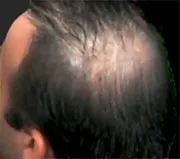But experts note the findings are preliminary, don't amount to cure for baldness yet
WebMD News from HealthDay

By Randy Dotinga
HealthDay Reporter
MONDAY, Oct. 21 (HealthDay News) -- There's new hope for anyone who's bald or balding: Researchers report they're getting closer to the goal of cloning hair cells and coaxing them to grow hair once they're replanted in the scalp.
"We've been able to overcome the first block," said study co-author Angela Christiano, a professor of dermatology and genetics & development at the Center for Human Genetics at Columbia University's College of Physicians & Surgeons in New York City.
For now, the research is in the early stages. Questions about costs and possible side effects remain unanswered, and it's not clear whether the technique will produce the kind of hair that people want in terms of traits like texture.
At issue is the need for a better way to replace hair in people who lose it, including an estimated 50 percent of people over the age of 50 who suffer from hair loss.
There are drugs to help people with hair loss, but they tend to focus on stimulating existing hair follicles to grow longer hairs, Christiano explained. In male-pattern baldness, men still have follicles that grow hair, but they produce "peach fuzz" instead of normal hair.
There are other treatment options, but they're not much better, one expert added.
"Surgical methods, mainly hair transplants, really just shuffle existing hair around from [the] back of scalp to front of scalp," said Dr. Luis Garza, an assistant professor at Johns Hopkins School of Medicine in Baltimore. "The main challenge is to grow a new hair follicle."
This new approach may also help more than just men with hair loss.
"About 90 percent of women with hair loss are not strong candidates for hair transplantation surgery because of insufficient donor hair," Christiano said in a university news release. "This method offers the possibility of inducing large numbers of hair follicles or rejuvenating existing hair follicles, starting with cells grown from just a few hundred donor hairs. It could make hair transplantation available to individuals with a limited number of follicles, including those with female-pattern hair loss, scarring alopecia and hair loss due to burns."
In the new study, Christiano and her colleagues sought to figure out how to take hair cells from the body, clone them and then reinsert them back into the body where they'll grow new hair from new follicles. The process falls apart because the cells lose the ability to instruct the skin to make new hair, she explained.
In the new study, researchers found that the cells retain their ability to figure out what to do when the researchers grow the cells upside down. "We don't put genes into them, and they're not manipulated at all," Christiano noted.
The hair cells produced by the process were able to produce new hair in five out of seven donor models of human skin, she said, although there's more work to be done to make them fully develop hair the way they should.
The technique holds potential for more than cosmetic treatments to help people grow new hair. Among other things, the research could ultimately lead to more functional replacement skin for people with scars and burns because the skin would have hair, Christiano said.
Garza praised the research, but emphasized that it is preliminary. "This work helps to climb the mountain, but there are miles to go and more steep terrain ahead," he said.
The study appears online Oct. 21 in the Proceedings of the National Academy of Sciences.
source : Researchers Report Progress With Growing Hair








